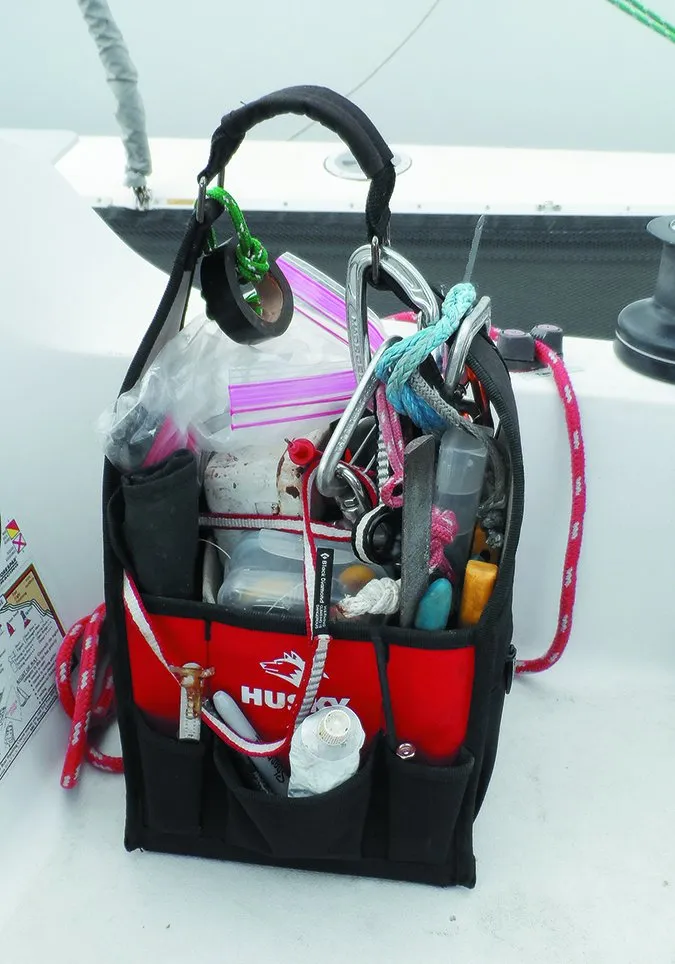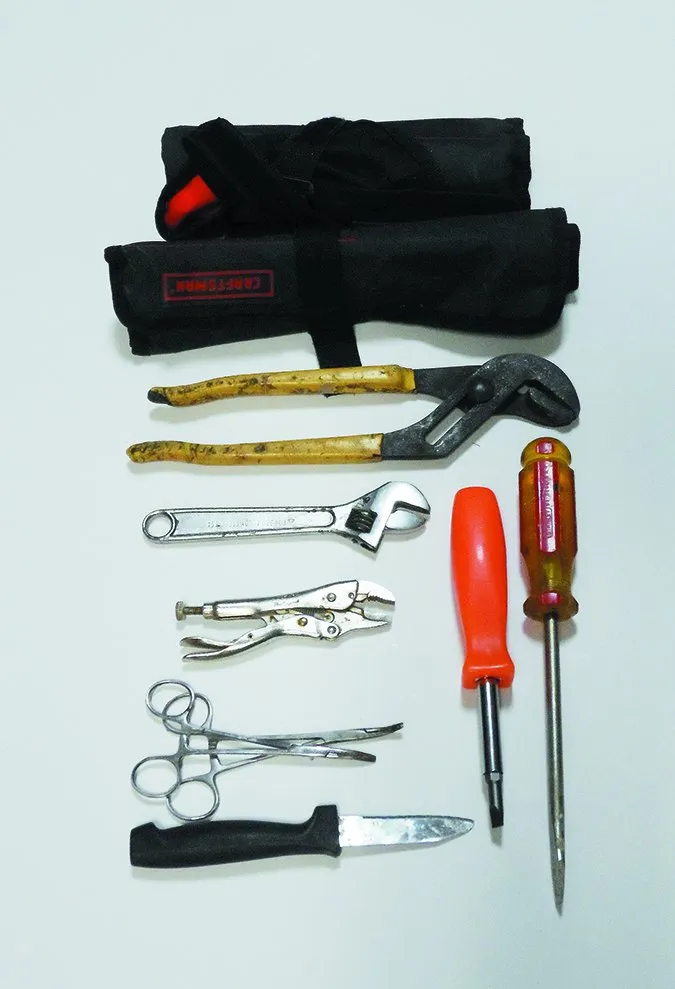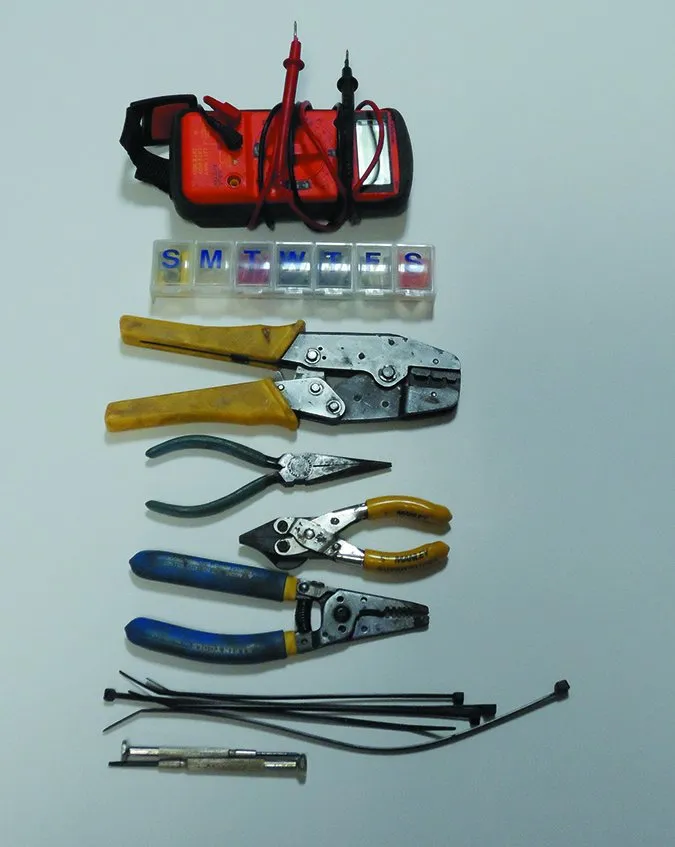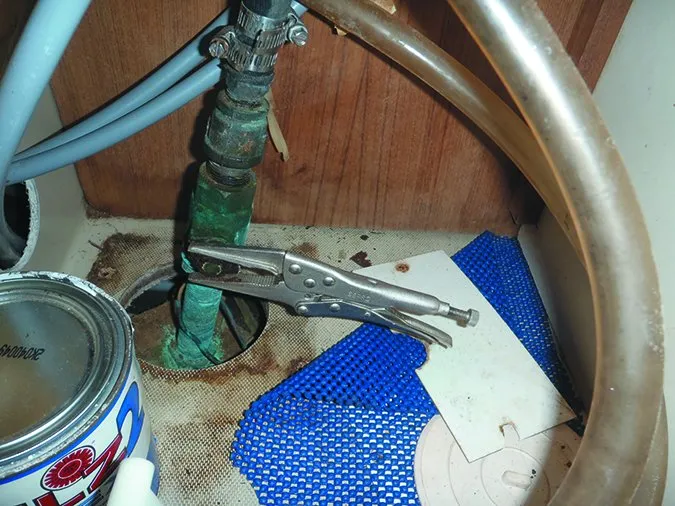The tools and materials required to maintain and repair everything on a boat will barely fit in a room. Just the kit required to maintain vital systems will raise the waterline of a large boat and is impractical in a smaller boat. Fortunately, when day sailing and even cruising locally, all we really need to do is get back to the dock … any dock.
Instead of preparing for every contingency, our tech editor Drew Frye has developed this small kit that he carries from boat to boat, whether day sailing on his Corsair F-24 or setting out on a test sail. While it doesn’t contain everything hed like to have, it holds enough to get most small boats home for dinner. In 35 years of sailing he has yet to require assistance on the water and he plans to keep it that way.
Although the kit will differ slightly from boat to boat, the contents should focus on fixing the essentials; propulsion, steering, and keeping the water out. A few items are too big to fit in a convenient bag (ropes, boat hook, and a wet suit for cooler water), but they should be on the boat.

Drew Frye
Sails and Rigging Repairs
Although a dismasting far from shore is beyond the scope of this kit, most other sail and rig trouble can be managed with some rope that should be on the boat and a few carefully selected pieces of equipment. Common problems are torn sails (reef or change sails), failed blocks (create a jury rig from a few shackles, carabiners, slings, or a snatch block), and broken lines (reeve a spare or redirect an unused line). Reefing will reduce the loads on your jury rig.
The Tools
A selection of shackles, soft shackles, and carabiners. A snatch block is handy, but a pair carabiners and a soft shackle will substitute.
Some 6- to 50-foot lengths of rope. Should be on the boat.
Polyester cord. A sailors duct tape. Dyneema sounds like the modern version, but it can be too slippery, so bring both.
Tape. Sail repair tape, electrical tape, and athletic tape.
Sail repair kit. A stitch in time can save nine. A small spool of #4 whippingtwine, a needle and palm, a knife, a roll of sail repair tape, and a few yards of webbing can handle most minor problems. Include reinforced Mylar tape for laminate sails, since needle holes function like the tear-here perforations on a magazine subscription card. If you must stitch, stitch through a layer of polyester sail repair tape.
Rigging wire. We like monel because it is more malleable.
Outboard Engine Repairs
Since our focus here is on small daysailers, well only talk about outboards here. It helps to learn enough about motors to diagnose the really simple stuff. Unlike cars, most don’t run on computers. However, unless the problem is simple to fix, you’ll be sailing home.
If your destination has strong currents wait for slack tide. Choosing an alternate destination is also an option.

Drew Frye
Sail to an anchorage. When choosing the anchorage, consider the wind direction, including morning conditions; its no use reaching up a narrow creek, only to face an impossible tacking battle in the morning. Practice setting and recovering the hook under sail. The sail plan for sailing on and off the anchor will vary by boat, and situation. Where ever you anchor assume you may have to sail off. Hopefully, by morning you may have sorted the engine problem out.
Sail into your slip. Safety should be your guide, but this is often not as unreasonable as it sounds. Again, the sail plan for this will vary by situation, the idea is to set the minimum maintain maneuverability. Furling sails come in handy here. Remember that you have no brakes (backing the jib does very little and will make the boat turn away) so have a bail-out plan.
Sail close and anchor. If you can’t get right into your slip, then either kedge in, beg a tow, or use the tender. In a small boat, you can probably nose up to a piling or finger pier and then warp into a slip.
But lets say you really need the engine. If the engine was running well earlier, chances are good it is something very simple.
Air leak. The tiniest suction leak in the fuel hose can make the pump cavitate. These can be brought on by motion underway or lifting and lowering an outboard. Look for loose clamps, cracked lines, and cracked fittings where the fuel line attaches to the pump or outboard. Generally, there will be some evidence of leakage, but some only leak inwards or when the engine shakes.
Water in the fuel. It was OK when you left the dock, but got stirred up underway. Is there low drain point (possible with diesel, never with gasoline)? Worst case scenario, borrow a fuel line from somewhere, bail some good fuel off the top into a dry soda bottle, duct tape it to a bulkhead (only above deck if gasoline) and run off that. This requires close attention, but I’ve done it twice.
Clogged filter. If it is an outboard, most dinghies and small kicker filters are practically interchangeable and you have one in the bag. If its a diesel with a large filter, hope the owner has a spare on board. If there are multiple filters, can one be safely by-passed?
No ignition? Install a new plug or clean the one you have. Probably not much else you can fool with at sea.
Flooded? Very common with certain motors. You must close the choke to get them to start, but if you pull more than twice, open it too soon or throttle down too soon, the intake loads up. Push the choke in and go do something else for 10 minutes. Pull 2-3 times with the choke in, then pull it out and see if it coughs.
Outboard engine won’t stay down (broken tilt lock). Tie it down with rope.
Shifting or throttle linkages not working. Disconnect and operate manually at the transmission or engine. Vise grips or cord can help.
Tools for Outboard Engine Repairs
- End wrenches in a roll. A light spray of rust preventative will keep them rust-free. Unlike a plastic case, it won’t slide off the deck.
- Pliers, several types.
- Adjustable wrench and vise grips.
- Several sparkplug wrenches.
- Screwdrivers. One multi-type, and several straight and phillips.
- Strap wrench for filters.
- Small wire brush and some emery cloth.
- Waterproof grease.
- Small flashlight for seeing in tight corners.
- In-line fuel filter and some small hose clamps.
- A few short lengths of fuel hose and a few fittings and barbs and splicers.
- Hacksaw blade.
- Swim goggles. A mask is better. Also a wet suit or drysuit if the water is too cold for swimming.
Electrical Boat Repairs

Drew Frye
Electrical problems can be related to the engine, but running lights and sump pumps are also vital. The trouble is usually a broken wire (splice it), corroded fitting (replace), or a bad connection (clean, grease, and re-connect).
Tools
Crimping tools, including strippers, ratchet crimpers, and a small collection of fittings and heat shrink is essential. Pill bottles work well for stowing these. Sure, you could splice wires together and wrap with tape for a temporary connection, but crimping is fast, ensures a more positive connection, and will stand up better to vibration.
Multimeter. A mid-level multimeter that measures AC/DC voltage, AC/DC current, frequency, capacitance, resistance, tests diodes, and checks continuity will be more than enough.
Cable ties. Not so much for wiring as for other things.
Five feet of #14 twin lead wire. If you need smaller, trim a few strands off the end. If you need bigger, double it.
Barbecue lighter. Use this for shrinking tubing and melting fresh cut ropes.
Steering Problems
More boats are probably rescued for loss of steering than taking on water or bad weather. Something jams and all you can do is go in circles.
Steering cable or chain breaks. You should have an emergency tiller at the ready (not the bottom of a locker). Regularly check for fit and function.
Broken or jammed rudder. Although emergency rudders are possible, steering with a drogue is far simpler and can be rigged with what you have on hand in 15 minutes. It works under sail but is even easier under power (see Steering Without a Rudder for the details). An anchor suspended closely under a fender makes a good jury drogue.
Wrapped a rope around the rudder or propeller. Crab pots and lobster pots are a common hazard, but also loose bits of floating fishing line and nets. Often diving with a knife is the only answer, but sometimes a boat hook or a pair of boat hooks can maneuver it off.
Keeping Water Out of the Boat
If the electric bilge pump isn’t working, it is probably due to either a bad wire or connection, the automatic float switch is stuck or failed (perhaps you can bypass it). A dirty bilge can lead to clogging; clean the strainer, and if there is a check valve, check that too.
Duct tape. Failed hoses and pipes can be patched with duct tape (use lots), tightly wrapped with parachute cord or braced with hose clamps. For larger holes, wrap a layer of tape, insert a slightly oversized flexible metal or plastic patch, and tape over that.
Hose clamps. For -inch to 1 -inch hoses. Although not the strongest, those with continuous slots fit more sizes. If they are all the same type and width, they can be combined to get home.
Butyl tape. No curing time, works wet, and it doesn’t dry up in the bag.
Bucket. Sometimes the pump just can’t get going.
Avoid Repairs with Diligent Maintenance
Most of these hypothetical repairs (no-never happened to us!) might have been avoided if we had inspected the boat regularly and taken what we noticed to heart. A thorough inspection in the spring and at mid-season is a good use of time, and a sailor should always be listening to the engine and looking at the rigging for changes.
The Sailboat Tool Bag
On larger boats, the sky is the limit as to what you can carry. For smaller cruisers, everything can fit in one bag. Some folks like a zippered bag. That’s smart, since nothing can fall out. But these bags can make it hard find anything either.
With an electricians bag (see photo), it constantly reminds me of everything that we have, allowing us to make better use of fewer things. They are made for working up ladders, and so we can hang it if need be, and cleaned out, it doubles as riggers bag for masthead work.
Conclusion
Your kit, of course, should be tailored to fit your boat. Aim to keep the boat afloat and under way. You don’t need to fix what’s broke, just get her safely pointed in the right direction.
































